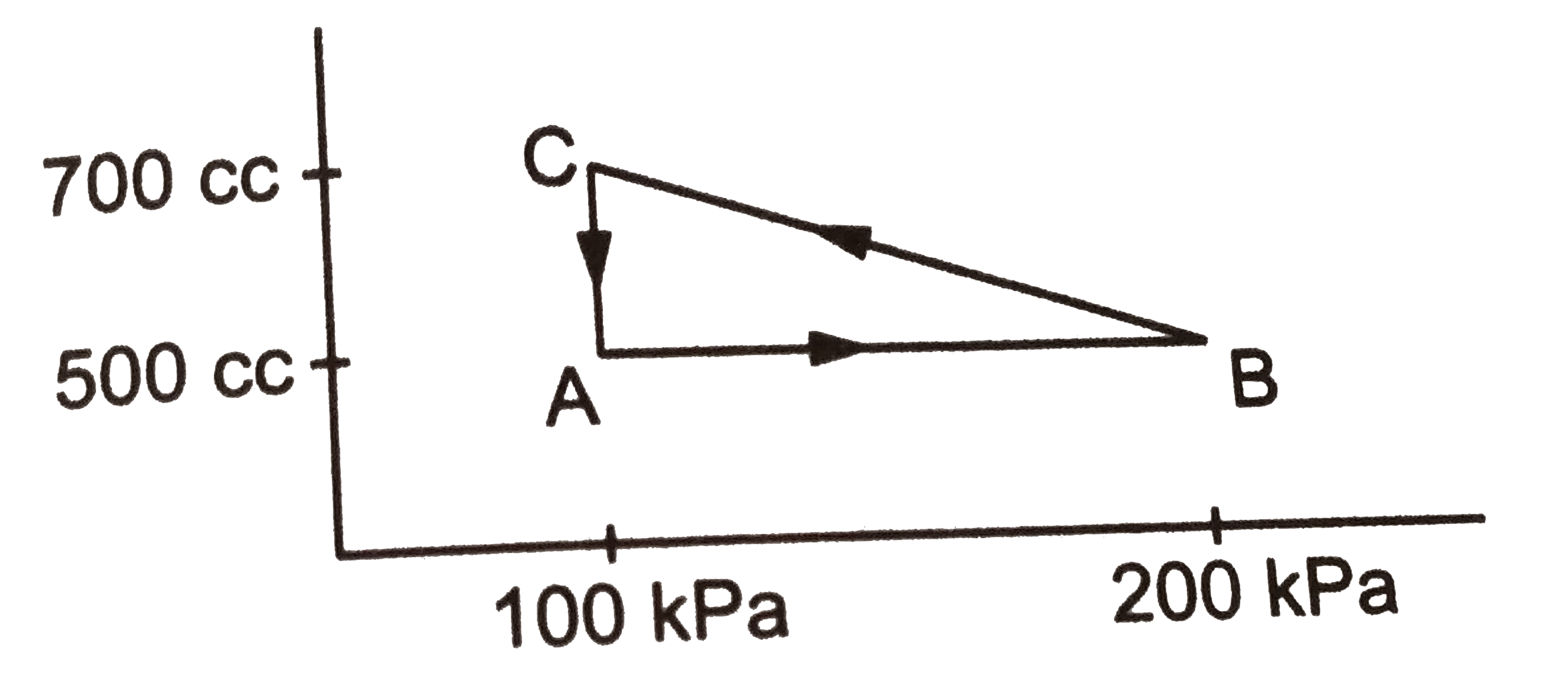An ideal gas is taken through a cyclic thermodynamic process through four steps. The amounts of heat involved in these steps are Q1=5960J, Q2=−5585J, Q3=−2980J and Q4=3645J respectively. The corresponding quantities of work involved are W1=2200J, W2=−825J, W3=−1100J and W4 respectively.
(a) Find the value of W4.
(b) What are the efficiency of the cycle?
In a cyclic process, ΔW=ΔQ
W1+W2+W3+W4=Q1+Q2+Q3+Q4
2200−825−1100+W4=5960−5585−2980
+3645
275+W4=1040
W4=1040−275=765J
(b) Efficiency η=work doneheat abosorbed
=ΔWQ1+Q4=10405960+3645=10409605
=0.1083 i.e., 10.83%
Topper's Solved these Questions
Similar Questions
An ideal gas is taken through a cyclic thermodynamic process through four steps. The amounts of heat involved in these steps are Q1=5960J,Q2=−5585J,Q3=−2980JandQ4=3645J, respectively. The corresponding quantities of work involved are W1=2200J,W2=−825J,W3=−1100JandW4 respectively.
(1) Find the value of W4.
(2) What is the efficiency of the cycleView SolutionAn ideal gas is taken through a cyclic thermodynamic process through four steps. The amount of heat involved in four steps areQ1=6000J,Q2=−5000J,Q3=5000JandQ4=4000JandW=2000J
respectively. If efficincy of cycle is 10x% then find value of x?View Solution
Knowledge Check
- Question 1 - Select One
An ideal gas is taken through a cyclic thermodynamical process through four steps. The amounts of heat involved in these steps areQ1=5960J,Q2=−5585J,Q3=and−2980JQ4=3645J, respectively . The corresponding works involved are W1=2200J,W2=−825J,W3=and−1100JW4 respectively. The value of W4 is
A1315 JB275 JC765 JD675 J - Question 2 - Select One
Choose the most appropriate option.
An ideal gas is taken through a cyclic thermodynamical process through four steps. The amounts of heat involved in these steps are Q1=5960J,Q2=−5585J,Q3=−2980JandQA=3645J, respectively. The value of W4 isA1315JB275JC765JD675J - Question 3 - Select One
An ideal gas is made to go through a cyclic thermodynamical process in four steps. The amount of heat involved are Q1=600J,Q2=−400J,Q3=−300J and Q4=200J respectively. The corresponding work involved are W1=300J,W2=−200J,W3=−150J and W4. The value of W4 is
A−50JB100JC150JD50J
A gas is taken through a cyclic process ABCA as shown in, if 2.4 cal of heat is given in the process, what is the value of J ?
 View Solution
View SolutionAn ideal gas is made go to through a cyclic thermodynamics process in four steps. The Q2=300J,Q3=−400J,Q4=−100J respectively. The corresponding works involved are W1=300J,W2=−100J,W3=100JandW4. What is the value of W4?
View SolutionAn ideal gas after going through a series of four thermodynamic states in order, reaches the initial state again (cyclic process). The amounts of heat (Q) and work (W) involved in the states are,
Q1=6000J,Q2=−5500J,
Q3=−3000J,Q4=3500J
W1=2500J,W2=−1000J,
W3=−1200J,W4=×J
The ratio of net work done by the gas to the total heat absorbed by the gas in η. The value of x and η are nearly :-View SolutionAn ideal gas after going through a series of four thermodynamic states in order, reaches the initial state again (cyclic process). The amounts of heat (Q) and work (W) involved in the states are,
Q1=6000J,Q2=−5500J,
Q3=−3000J,Q4=3500J
W1=2500J,W2=−1000J,
W3=−1200J,W4=×J
The ratio of net work done by the gas to the total heat absorbed by the gas in η. The value of x and η are nearly :-View SolutionAn ideal gas is subjected to cyclic process involving four thermodynamics thates, the amounts of heat (Q) and work (W) involved in each of these states.
Q1=6000J,Q2=−5500J,Q3=−3000J,Q4=3500J
W1=2500J,W2=−1000J,W3=−1200J,W4=xJ The ratio of the net work done by the gas to the total heat absorbed by the gas is η. The values of x and η respectively areView Solution

